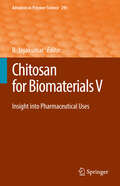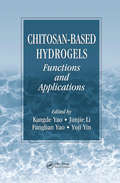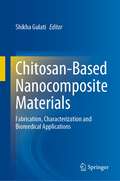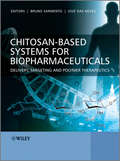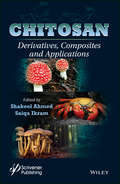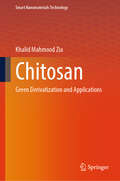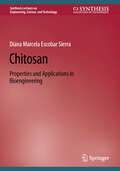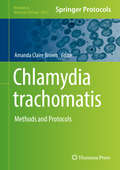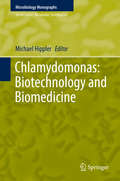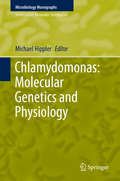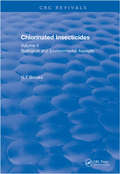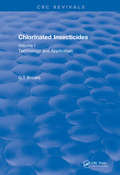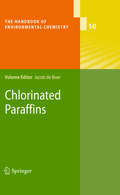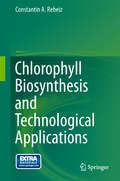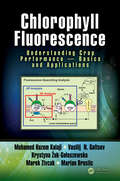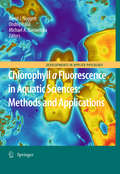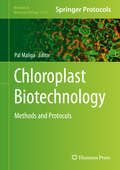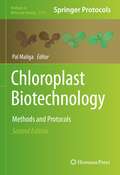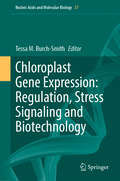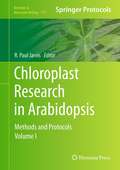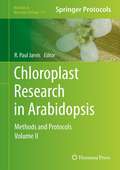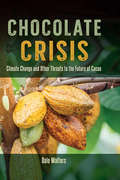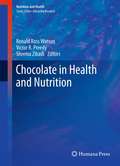- Table View
- List View
Chitosan for Biomaterials V: Insight into Pharmaceutical Uses (Advances in Polymer Science #295)
by R. JayakumarThis volume offers an overview of Chitosan's role in facilitating peptide and biomolecule delivery, microbial resistance in wound care, tissue engineering, hemostasis, and drug delivery. It further delves into the challenges and potential applications of chitosan and its chemically modified derivatives within the pharmaceutical industry, with a particular focus on ocular and oral drug delivery, as well as targeted drug delivery systems. Moreover, this volume sheds light on the prominent use of chitosan and its derivatives, whether in their original forms or as membranes, beads, scaffolds, or films, within the domains of tissue engineering, wound healing, and hemostasis. Collectively, this comprehensive exploration aims to enhance our understanding of recent advancements and innovative chitosan-based systems in pharmaceutical and nutraceutical applications, thereby illuminating the myriad possibilities that lie ahead.
Chitosan-Based Hydrogels: Functions and Applications
by Junjie Li Kangde Yao Fanglian Yao Yuji YinDue to their unique properties, chitosan-based materials have emerged as useful resources in a variety of medicines, drug controlled-release carriers, tissue engineering scaffolds, and immobilized enzymes. But many of these materials have yet to reach the commercial market. Therefore, more work must be completed to fill the gap between research and
Chitosan-Based Nanocomposite Materials: Fabrication, Characterization and Biomedical Applications
by Shikha GulatiThis book highlights the state-of-the-art research and discovery in the use of chitosan-based nanocomposites in biomedical applications, including the scope to which these novel materials have been incorporated by the community. It provides an exceptional insight into the strategies for the synthesis and chemical modifications of chitosan, characterization techniques, their use as anticancer agents, antimicrobial, antiviral, and antifungal agents, their role in the biomedical field, and applications in drug delivery, gene therapy, dentistry, orthopedics, etc. This book will also emphasize the challenges with previous signs of progress and way for further research, details relating to the current pioneering technology, and future perspectives with a multidisciplinary approach. Furthermore, it presents up-to-date information on the economics, toxicity, and regulations related to these novel materials.
Chitosan-Based Systems for Biopharmaceuticals
by Jose Das Neves Bruno SarmentoChitosan is a linear polysaccharide commercially produced by the deacetylation of chitin. It is non-toxic, biodegradable, biocompatible, and acts as a bioadhesive with otherwise unstable biomolecules - making it a valuable component in the formulation of biopharmaceutical drugs.Chitosan-Based Systems for Biopharmaceuticals provides an extensive overview of the application of chitosan and its derivatives in the development and optimisation of biopharmaceuticals. The book is divided in four different parts. Part I discusses general aspects of chitosan and its derivatives, with particular emphasis on issues related to the development of biopharmaceutical chitosan-based systems. Part II deals with the use of chitosan and derivatives in the formulation and delivery of biopharmaceuticals, and focuses on the synergistic effects between chitosan and this particular subset of pharmaceuticals. Part III discusses specific applications of chitosan and its derivatives for biopharmaceutical use. Finally, Part IV presents diverse viewpoints on different issues such as regulatory, manufacturing and toxicological requirements of chitosan and its derivatives related to the development of biopharmaceutical products, as well as their patent status, and clinical application and potential.Topics covered include:chemical and technological advances in chitins and chitosans useful for the formulation of biopharmaceuticalsphysical properties of chitosan and derivatives in sol and gel statesabsorption promotion properties of chitosan and derivativesbiocompatibility and biodegradation of chitosan and derivativesbiological and pharmacological activity of chitosan and derivativesbiological, chemical and physical compatibility of chitosan and biopharmaceuticalsapproaches for functional modification or crosslinking of chitosanuse of chitosan and derivatives in conventional biopharmaceutical dosage formsmanufacture techniques of chitosan-based microparticles and nanoparticles for biopharmaceuticalschitosan and derivatives for biopharmaceutical use: mucoadhesive propertieschitosan-based systems for mucosal delivery of biopharmaceuticalschitosan-based delivery systems for mucosal vaccinationchitosan-based nanoparticulates for oral delivery of biopharmaceuticalschitosan-based systems for ocular delivery of biopharmaceuticalschemical modification of chitosan for delivery of DNA and siRNAtarget-specific chitosan-based nanoparticle systems for nucleic acid deliveryfunctional PEGylated chitosan systems for biopharmaceuticalsstimuli-sensitive chitosan-based systems for biopharmaceuticalschitosan copolymers for biopharmaceuticalsapplication of chitosan for anti-cancer biopharmaceutical deliverychitosan-based biopharmaceuticals scaffolds in tissue engineering and regenerative medicinewound healing properties of chitosan and its use in wound dressing biopharmaceuticalstoxicological properties of chitosan and derivatives for biopharmaceutical applicationsregulatory status of chitosan and derivativespatentability and intellectual property issuesquality control and good manufacturing practicepreclinical and clinical use of chitosan and derivatives for biopharmaceuticalsChitosan-Based Systems for Biopharmaceuticals is an important compendium of fundamental concepts, practical tools and applications of chitosan-based biopharmaceuticals for researchers in academia and industry working in drug formulation and delivery, biopharmaceuticals, medicinal chemistry, pharmacy, bioengineering and new materials development.
Chitosan: Derivatives, Composites and Applications
by Saiqa Ikram Shakeel AhmedThis book delves deeply in to the preparation, characterization and multiple applications of chitin and chitosan. The 17 chapters written by leading experts is an excellent reference source and state-of-the-art review for researchers and scientists using chitosan or biopolymers in their respective areas. This book is divided into following sections:• Production and derivatives of chitosan• Chitosan in the textile and food industries• Chitosan in biomedical applications• Chitosan in agriculture and water treatment The book is practical as readers will be able to see descriptions of chitosan production methods as well as techniques that can be used to estimate and modify their physical and chemical properties. It provides a full description not only of the traditional and recent developments in the applications of chitosan in the fields of biotechnology, environmental studies, food, medicine, water treatments, drug delivery, but it includes all of the therapeutically usages as well.
Chitosan: Green Derivatization and Applications (Smart Nanomaterials Technology)
by Khalid Mahmood ZiaThis book highlights the latest advances and novel technologies for the preparation, functionalization, and green derivitization of chitosan nanoparticles. The modification, biomedical applications, regulatory status and clinical trials of chitosan and its derivatives are also presented. Effective and innovative strategies enable increased influence on final characteristics, stability, and sustainability of chitosan nanoparticles. The book begins by examining chitosan nanoparticles, preparation and functionalization of the chitosan derivatives. This is followed by in-depth coverage of green derivatization and modification of chitosan nanoparticles (CSNPs), regulatory status and clinical trials of chitosan and derivatives, characterization techniques for the chitosan nanoparticles and derivatives along with key applications of modified CSNPs in water, food and agriculture industries, and biomedical applications including chemotherapy. The final chapters provide detailed discussions on chitosan as tools to combat COVID-19 and recent challenges and future prospectus of green derivatized chitosan nanoparticles.
Chitosan: Properties and Applications in Bioengineering (Synthesis Lectures on Engineering, Science, and Technology)
by Diana Marcela Escobar SierraChitosan: Properties and Applications in Bioengineering presents a review of chitosan, including information regarding its structure, main properties, available sources, extraction, and processing techniques. It presents the different applications of chitosan as a biomaterial in fields such as medicine and the agricultural, cosmetology, pharmaceutical, and food industries to have readers obtain a more technical vision of the current use of this biopolymer. The book has been researched and written based on the data collected through several years of work in the Biomaterials Research Group, part of the University of Antioquia Bioengineering Program. This concise guide will be valuable for researchers and students in biomaterials, bioengineering, the basic sciences, chemical engineering, and biomedical engineering.
Chlamydia trachomatis: Methods and Protocols (Methods in Molecular Biology #2042)
by Amanda Claire BrownThis book explores cutting-edge methods to work with the notoriously difficult, but highly prevalent, obligate intracellular pathogen, Chlamydia trachomatis. These include techniques to identify Chlamydia trachomatis in patient samples, ranging from simple point-of-care tests to whole genome sequencing; methods for propagation of strains in both cell culture and animal models; techniques to manipulate Chlamydia trachomatis in molecular genetic methodologies; a high-throughput screening method for testing new potential drugs against intracellular bacteria; a screen for antibiotic resistance; methods for labeling and enumeration; and descriptions of genotyping technologies, as well as dual RNA-Seq transcriptional profiling. Written for the highly successful Methods in Molecular Biology series, chapters include introductions to their respective topics, lists of the necessary materials and reagents, step-by-step, readily reproducible laboratory protocols, and tips on troubleshooting and avoiding known pitfalls. Authoritative, practical, and relevant, Chlamydia trachomatis: Methods and Protocols serves as an ideal reference for scientists searching for a better understanding of the pathogen, allowing for the development of improved treatment regimens and the discovery of new drugs.
Chlamydomonas: Biotechnology and Biomedicine (Microbiology Monographs #31)
by Michael HipplerThis Microbiology Monographs volume covers the current and most recent advances in genomics and genetics, biochemistry, physiology, and molecular biology of C. reinhardtii. Expert international scientists contribute with reviews on the genome, post-genomic techniques, the genetic toolbox development as well as new insights in regulation of photosynthesis and acclimation strategies towards environmental stresses and other structural and genetic aspects, including applicable aspects in biotechnology and biomedicine. Advancement in Chlamydomonas biology allowed new understandings in biotechnological and biomedical related aspects.
Chlamydomonas: Molecular Genetics and Physiology (Microbiology Monographs #30)
by Michael HipplerThis Microbiology Monographs volume covers the current and most recent advances in genomics and genetics, biochemistry, physiology, and molecular biology of C. reinhardtii. Expert international scientists contribute with reviews on the genome, post-genomic techniques, the genetic toolbox development as well as new insights in regulation of photosynthesis and acclimation strategies towards environmental stresses and other structural and genetic aspects, including applicable aspects in biotechnology and biomedicine. Powerful new strategies in functional genomic and genetics combined with biochemical and physiological analyses revealed new insights into Chlamydomonas biology.
Chlorinated Insecticides: Biological and Environmental Aspects Volume II (CRC Press Revivals)
by G.T BrooksVolume I of Chlorinated Insecticides considered the technology of these compounds in a historical context, tracing their development up to the resent time. The accounts of the numerous applications in insect control given there provide a link with Volume II in that they pose many questions about the interactions of these compounds with living organisms. Some of these questions will be examined in the Subsequent Chapters of this book.
Chlorinated Insecticides: Technology and Application Volume I (CRC Press Revivals)
by G.T BrooksThis definitive and most detail work ever to have been published, devoted exclusively to the chemistry and biology of chlorinated insecticides, comes from the authoritative pen of a leading investigator in this field. It should serve for many years to come as the prime reference source both for instructional and research purposes, for it not only delineates that which is known about this valuable class of compounds, but also emphasises those important biological and ecological areas in which our knowledge is still much too sketchy and in which further investigation may be expected to uncover facts of great interest and wide applicability.
Chlorinated Paraffins (The Handbook of Environmental Chemistry #10)
by C. De BoerChlorinated paraffins are one of the last classes of chlorinated compounds that are still being produced worldwide and used in high quantities in many applications. They are particularly used in cutting oils in the metal industry, but also as lubricants, plasticizers, flame retardants and as additives in adhesives, rubber, paints and sealants. This volume covers the state-of-the-art of methods for the synthesis and analysis of chlorinated paraffins. Experts in the field provide an overview of their worldwide occurrence and utilization and describe their toxicological properties. International regulations and production volumes are presented as well as an example of a risk assessment study that was carried out in Japan. This book is a valuable and comprehensive source of information for environmental scientists interested in the occurrence and toxicology of chlorinated paraffins and for authorities and producers.
Chlorophyll Biosynthesis and Technological Applications
by Constantin A. RebeizHeme and chlorophyll (Chl) are porphyrins. Porphyrins (also referred to as tetrapyrroles) are essential for life in the biosphere. Chlorophyll catalyzes the conversion of solar energy to chemical energy via the process of photosynthesis. Organic life in the biosphere is made possible by consumption of the chemical energy generated by photosynthesis. Hemes are the prosthetic groups of cytochromes which are involved in electron transport during oxidative phosphorylation and photosynthetic phosphorylation which generate ATP and NADPH. The latter are essential for many cellular functions. Chlorophyll on the other hands catalyzes the process of photosynthesis. Indeed, life in the biosphere depends on the process of photosynthesis which converts light energy, carbon dioxide and water into the chemical energy, required for the formation of food and fiber. Photosynthetic efficiency is controlled by extrinsic factors such as the availability of water, CO2, inorganic nutrients, ambient temperature and the metabolic and developmental state of the plant, as well as by intrinsic factors (Lien and San Pietro, 1975). The most important intrinsic factor is the efficiency of the photosynthetic electron transport system (PETS). Conventional agriculture is one of the few human activities that have not undergone a revolution to join other activities such as overcoming gravity by flying, and landing on the moon, crossing underwater the polar cap, and communicating wirelessly over long distances via electromagnetic waves. We now feel that enough biochemical and molecular biological knowledge has accumulated to render this dream amenable to experimentation. We believe that the time has come to bioengineer chloroplasts capable of synthesizing a short chain carbohydrate such as glycerol at rates that approach the upper theoretical limits of photosynthesis [Rebeiz, C. A. (2010) Investigations of possible relationships between the chlorophyll biosynthetic pathway and the assembly of chlorophyll-protein complexes and photosynthetic efficiency. In: Rebeiz, C. A. Benning, C. , Bohnert, H. J. , Daniell, H. , Hoober J. K. , Lichtenthaler, H. K. , Portis , A. R. , and Tripathy, B. C. eds. The chloroplast: Basics and Applications. Springer. The Netherlands, p 1-24]. In order to achieve this goal a thorough knowledge of the Chl biosynthetic pathway is needed along with knowledge in other domains (Rebeiz 2010). In this context, this monograph is devoted to an in depth discussion of our present knowledge of the Chl biosynthetic pathway. The complexity and biochemical heterogeneity of the Chl biosynthetic pathway and the relationship of this complexity to the structural and biosynthetic complexity of photosynthetic membranes will be emphasized. We will also emphasize in historical perspective, key stages in our understanding of the Chl biosynthetic heterogeneity. The reader should keep in mind that a complex biosynthetic process is only fully understood when it becomes possible to reconstitute in vitro every step of the process. We are not yet at this stage of understanding of thylakoid membrane biogenesis. Considerable progress has been achieved however, in the understanding of numerous facets of the Chl biosynthetic pathway, namely (a) detection and identification of various major and minor metabolic intermediates (b) precursor-product relationships between various intermediates, (c) structure and regulation of many enzymes of the pathway, and (d) the relationship of the Chl biosynthetic heterogeneity to the structural and functional heterogeneity of thylakoid membranes. In addition topics related to the development of Analytical techniques, Cell-free systems, Herbicides, Insecticides, and Cancericides are also discussed.
Chlorophyll Fluorescence: Understanding Crop Performance — Basics and Applications
by Mohamed H. Kalaji Vasilij N. Goltsev Krystyna Żuk-Gołaszewska Marek Zivcak Marian BresticChlorophyll a fluorescence is a tool for evaluating plant responses to stress conditions. Fluorescence can be used in plant phenotyping and breeding programs to monitor biotic and abiotic stresses including mineral deficiencies, soil salinity, and pathogenic diseases. Chlorophyll Fluorescence: Understanding Crop Performance — Basics and Applications reviews a diversity of instruments available for recording and analyzing different types of light signals from plants and addresses the use of chlorophyll a fluorescence in research on plants and other photosynthesizing organisms, such as algae and cyanobacteria. This book characterizes the phenomenon of chlorophyll a fluorescence, describes the methods for its measurement, and demonstrates — using selected examples — the applicability of these methods to research the response of the photosynthetic apparatus and plant tolerance to unfavorable environmental conditions. In addition, chapters cover a general background on photosynthesis, analysis of delayed fluorescence, and the pulse amplitude modulated (PAM) technique. The book is addressed to a wide range of professionals in photosynthesis research and scientists from other areas of plant sciences.
Chlorophyll a Fluorescence in Aquatic Sciences: Methods And Applications (Developments in Applied Phycology #4)
by Michael A. Borowitzka David J. Suggett Ondrej PrášilMeasurements of variable chlorophyll fluorescence have revolutionised global research of photosynthetic bacteria, algae and plants and in turn assessment of the status of aquatic ecosystems, a success that has partly been facilitated by the widespread commercialisation of a suite of chlorophyll fluorometers designed for almost every application in lakes, rivers and oceans. Numerous publications have been produced as researchers and assessors have simultaneously sought to optimise protocols and practices for key organisms or water bodies; however, such parallel efforts have led to difficulties in reconciling processes and patterns across the aquatic sciences. This book follows on from the first international conference on "chlorophyll fluorescence in the aquatic sciences" (AQUAFLUO 2007): to bridge the gaps between the concept, measurement and application of chlorophyll fluorescence through the synthesis and integration of current knowledge from leading researchers and assessors as well as instrument manufacturers.
Chloroplast Biotechnology: Methods and Protocols (Methods in Molecular Biology #1132)
by Pal MaligaIn Chloroplast Biotechnology: Methods and Protocols, expert researchers in the field detail many of the methods which are now commonly used in chloroplast molecular biology. Chapters focus on essential background information, applications in tobacco, and protocols for plastid transformation in crops, and Chlamydomonas and Bryophytes. Written in the highly successful Methods in Molecular Biology series format, chapters include introductions to their respective topics, lists of the necessary materials and reagents, step-by-step, readily reproducible laboratory protocols, and key tips on troubleshooting and avoidance of known pitfalls. Authoritative and practical, Chloroplast Biotechnology: Methods and Protocols seeks to aid scientists who study chloroplast molecular biology as well as those interested in applications in agriculture, industrial biotechnology, and healthcare. --
Chloroplast Biotechnology: Methods and Protocols (Methods in Molecular Biology #2317)
by Pal MaligaThis second edition volume expands on the previous edition with updated chapters in model systems and new crops. The book contains protocols for plastid engineering in leaves, tissue culture cells, and the shoot apex of plants, as well as for marker excision from the plastid genome and engineering Rubisco, the key enzyme of photosynthesis. Written in the highly successful Methods in Molecular Biology series format, chapters include introductions to their respective topics, lists of the necessary materials and reagents, step-by-step, readily reproducible laboratory protocols, and tips on troubleshooting and avoiding known pitfalls. Cutting-edge and practical, Chloroplast Biotechnology: Methods and Protocols, Second Edition is a valuable resource for researchers who wish to enter the field, and for practitioners looking for insights of applications in agriculture, industrial biotechnology and healthcare.
Chloroplast Gene Expression: Regulation, Stress Signaling and Biotechnology (Nucleic Acids and Molecular Biology #37)
by Tessa M. Burch-SmithThis book provides an insightful journey into the realm of chloroplast biology. Chloroplasts are the organelles that perform photosynthesis and many of the metabolic processes in plant cells. They are a specialized form of plastids, whose differentiation is dependent on environmental and developmental signaling. Descended from a lineage of free-living, photosynthesizing prokaryotes, chloroplasts and other plastids contain remnants of their ancient genomes and chloroplast gene expression is essential for establishing functional organelles. Chloroplast gene expression has features of the prokaryotic gene expression but now involves large suites of nuclear proteins. Topics discussed are: the identification of these nuclear factors how chloroplast RNA is processed to produce functional organelles translation in chloroplasts and its regulation the environmental factors that influence chloroplast development and how plants deal with defective chloroplasts. The book also highlights the evolving landscape of chloroplast engineering in biotechnology, recent breakthroughs and their implications for the future. A valuable resource for researchers, students, and enthusiasts alike, this book is a compelling testament to the fascinating world of chloroplasts and their burgeoning role in scientific innovation.
Chloroplast Research in Arabidopsis: Methods and Protocols, Volume I (Methods in Molecular Biology #774)
by R. Paul JarvisChloroplasts are essential for the survival and flourishing of life on Earth. Over the years, chloroplast biology has been studied in a variety of different organisms, leading to the significant disadvantage that findings which were made by using different experimental systems or species were not always directly cross-comparable. The relatively recent adoption of Arabidopsis thaliana as the model organism of choice for plant science research, across the globe, has led to its emergence as a pre-eminent system for research on chloroplasts and other types of plastid. In Chloroplast Research in Arabidopsis: Methods and Protocols, expert researchers bring together some of the most important, modern techniques and approaches for chloroplast research, with the unifying theme of Arabidopsis as the model system. Volume I explores topics such as genetics, cytology, in vivo analysis, gene expression, and protein accumulation, as well as protein transport, localization, and topology. Written in the highly successful Methods in Molecular BiologyTM series format, chapters include introductions to their respective topics, lists of the necessary materials and reagents, step-by-step, readily reproducible laboratory protocols, and tips on troubleshooting and avoiding known pitfalls. Authoritative and convenient, Chloroplast Research in Arabidopsis: Methods and Protocols serves as an ideal reference for all researchers with a general interest in chloroplasts, plastids, or related processes.
Chloroplast Research in Arabidopsis: Methods and Protocols, Volume II (Methods in Molecular Biology #775)
by R. Paul JarvisChloroplasts are essential for the survival and flourishing of life on Earth. Over the years, chloroplast biology has been studied in a variety of different organisms, leading to the significant disadvantage that findings which were made by using different experimental systems or species were not always directly cross-comparable. The relatively recent adoption of Arabidopsis thaliana as the model organism of choice for plant science research, across the globe, has led to its emergence as a pre-eminent system for research on chloroplasts and other types of plastid. In Chloroplast Research in Arabidopsis: Methods and Protocols, expert researchers bring together some of the most important, modern techniques and approaches for chloroplast research, with the unifying theme of Arabidopsis as the model system. Volume II explores topics such as multiprotein complexes, protein-protein interactions, omics and large-scale analyses, proteomics and suborganellar fractionation, as well as photosynthesis and biochemical analysis. Written in the highly successful Methods in Molecular BiologyTM series format, chapters include introductions to their respective topics, lists of the necessary materials and reagents, step-by-step, readily reproducible laboratory protocols, and tips on troubleshooting and avoiding known pitfalls. Authoritative and convenient, Chloroplast Research in Arabidopsis: Methods and Protocols serves as an ideal reference for all researchers with a general interest in chloroplasts, plastids, or related processes.
Chocolate Crisis: Climate Change and Other Threats to the Future of Cacao
by Dale WaltersChocolate is the center of a massive global industry worth billions of dollars annually, yet its future in our modern world is currently under threat. In Chocolate Crisis, Dale Walters discusses the problems posed by plant diseases, pests, and climate change, looking at what these mean for the survival of the cacao tree.Walters takes readers to the origins of the cacao tree in the Amazon basin of South America, describing how ancient cultures used the beans produced by the plant, and follows the rise of chocolate as an international commodity over many centuries. He explains that most cacao is now grown on small family farms in Latin America, West Africa, and Indonesia, and that the crop is not easy to make a living from. Diseases such as frosty pod rot, witches’ broom, and swollen shoot, along with pests such as sap-sucking capsids, cocoa pod borers, and termites, cause substantial losses every year. Most alarmingly, cacao growers are beginning to experience the accelerating effects of global warming and deforestation. Projections suggest that cultivation in many of the world’s traditional cacao-growing regions might soon become impossible.Providing an up-to-date picture of the state of the cacao bean today, this book also includes a look at complex issues such as farmer poverty and child labor, and examines options for sustainable production amid a changing climate. Walters shows that the industry must tackle these problems in order to save this global cultural staple and to protect the people who make their livelihoods from producing it.
Chocolate in Health and Nutrition (Nutrition and Health)
by Victor R. Preedy Ronald Ross Watson Sherma ZibadiChocolate in Health and Nutrition represents the first comprehensive compilation of the newest data on the actions of the flavonoids and microorganisms associated with the beneficial effects of chocolate. This unique text provides practical, data-driven resources based upon the totality of the evidence to help the reader understand the basics, treatments and preventive strategies that are involved in the understanding of the role chocolate may play in healthy individuals as well as those with cardiovascular disease, diabetes or neurocognitive declines. Of equal importance, critical issues that involve patient concerns, such as dental caries and food preferences in children, potential effects on weight gain, addiction and withdrawal are included in well-referenced, informative chapters. The latest research on the role of chocolate in normal health areas including mood, pain and weight management, cardiovascular disease and related conditions are presented. Chocolate in Health and Nutrition provides health professionals in many areas of research and practice with the most up-to-date, well referenced and comprehensive volume on the current state of the science and medical uses of chocolate.
Chocolate: Sweet Science & Dark Secrets of the World's Favorite Treat
by Kay FrydenborgChocolate hits all the right sweet--and bitter--notes: cutting-edge genetic science whisked in with a strong social conscience, history, and culture yield one thought-provoking look into one of the world's most popular foods. Readers who savored Chew on This and Food, Inc. and lovers of chocolate will relish this fascinating read.
